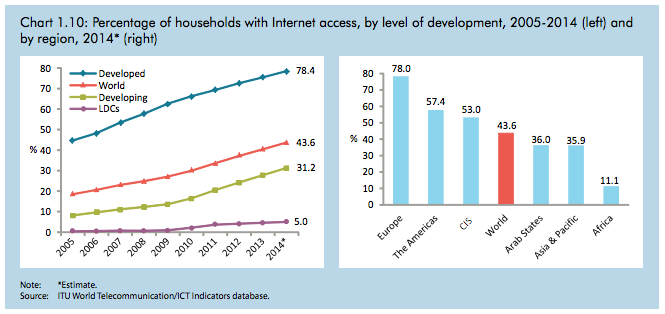The ITU, bless their binary souls, just released the 2014 Measuring the Information Society report. The headline is – or should be – that something is very wrong on the internet, and we need to fix it.

The ITU, bless their binary souls, just released the 2014 Measuring the Information Society report. The headline is – or should be – that something is very wrong on the internet, and we need to fix it.
I used to scoff at the phrase ‘digital divide’, which was used to soft-peddle the glaring technological inequalities between rich and poor nations. I still don’t like it, but for different reasons. I used to think that the technological gap between the developed and developing was evanescent, a transient blip which would rapidly disappear as wireless broadband technologies proved viable in even the most marginal markets.
Not so. At least, not so far. The 2014 ITU report shows a widening gap between rich and poor, in spite of the fact that growth in the global digital economy is driven entirely by the developing world.
Let’s look at who’s got access to broadband on their mobile:
The disparity between the richest and the poorest countries is glaring, and unlikely to right itself. The developed world and the Least Developed Countries are on completely different trajectories. Even the developing countries are showing a rate of increase that would require radical change even to come close to the level of ubiquity seen in Europe and North America.
The picture is nearly identical when we count the number of households with internet access:
 Shockingly, residential internet is showing evidence of having reached a plateau in LDCs. While the rate of uptake has improved in the last five years, it’s still hard to say when, if ever, the developing world will achieve similarity – let alone parity – when the richer world.
Shockingly, residential internet is showing evidence of having reached a plateau in LDCs. While the rate of uptake has improved in the last five years, it’s still hard to say when, if ever, the developing world will achieve similarity – let alone parity – when the richer world.
Don’t underestimate the importance of this metric. While mobile broadband has the most promise in terms of its ability easily to reach people in the developing world, that doesn’t mean we don’t need dedicated broadband at home. Why? Just imagine having to complete all your research for a Masters dissertation on your iPhone.
The contrast becomes even more stark when we consider data use:
 Once again, the developed and developing worlds are simply on different trajectories. When we consider the relative populations of Asia, Africa, Europe and the Americas, the disproportion – nay, distension – becomes even more dramatic.
Once again, the developed and developing worlds are simply on different trajectories. When we consider the relative populations of Asia, Africa, Europe and the Americas, the disproportion – nay, distension – becomes even more dramatic.
All of that would almost be palatable if the story were simply one of different economies moving at different rates. But that’s not the case. Let’s take a look at telco revenues:
 Global telecommunications revenue growth, in real and relative terms, is all in the developing world. Since 2007, telco revenues have remained more or less flat at a little under 1.3 trillion(!) dollars in the developed world. They have grown by half in the developing world in the same period. And when we look at percentage growth, the difference becomes even more dramatic.
Global telecommunications revenue growth, in real and relative terms, is all in the developing world. Since 2007, telco revenues have remained more or less flat at a little under 1.3 trillion(!) dollars in the developed world. They have grown by half in the developing world in the same period. And when we look at percentage growth, the difference becomes even more dramatic.
The question, ultimately, is simple: The developing world is creating dramatic investment opportunities for the telecommunications industry. So where is the dramatic, life-changing result for its peoples?

